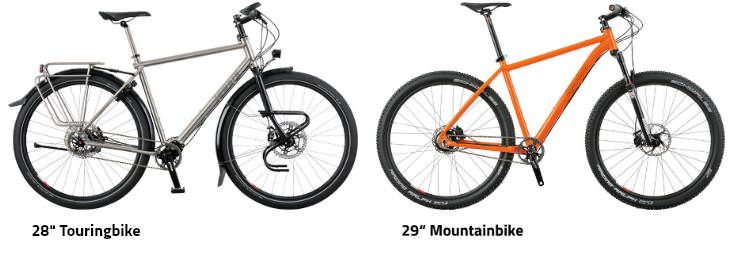Tyres
Bicycle tyres might somethimes get overlooked, but as they are the only part of the bike that actually touch the ground, it is important to get this right.
Different terrains call for different tyres and while more aggressive tyres might have more grip in the dirt, they will also most likely have a higher rolling resistance on sealed roads. Striking the right balance between the types of terrain you mostly ride on in important.
We offer Schwalbe tyres in various sizes, styles and tread patterns to suit different terrains.
What do the different sizes mean?
The sizes of bicycle tyres are now designated according to the European tire and rim standard ETRTO (European Tire and Rim Technical Organization). In practice, however, the older English and French names are also used.
The ETRTO size designation (e.g. 37-622) indicates the width (37 mm) and the inner diameter of the tire (622 mm). This designation is unambiguous and allows a clear assignment to the rim size.
The inch designation (e.g. 28 x 1.40) indicates the approximate outside diameter (28 inches) and the tire width (1.40 inches). There is also the inch designation in the form 28 x 1 5⁄8 x 1 3⁄8 (approximate outer diameter x tire height x tire width). The customs information is not precise and not clear. For example, diameters of 559mm (MTB), 571mm (triathlon) and 590mm (Dutch touring bikes) are all labeled 26-inch. Tires with a diameter of 622 and 635 mm are both referred to as 28 inches. Curiously, tyres with an inner diameter of 630 mm are called 27 inches. These designations have their origin - and their meaning - from the times of the tire brake that acted directly onto the tire. At that time, the exact outer diameter of the wheel and tire was dictated by the brake. Depending on the tire width, there were different standards for the inner diameter. In English language areas of the world and in MTB sports, the inch designations are widespread.
The French sizing (e.g. 700 x 35C) indicates the approximate outside diameter (700mm) and tire width (35mm). The letter at the end gives an indication of the inside diameter of the tyre. In this case, the C stands for 622 mm. The French designation does not exist for all tire sizes. B, for example not used for MTB sizes in the 700 sizes.
Which tyre fits which rim?
The inner diameter of the tire must match the rim bead seat diameter. For instance, a tire size 37-622 fits on a 622 x 19C rim.
Furthermore, the tire width must match the inner rim width. Download the lookup table here. It shows possible combinations of tire widths and inner rim widths according to ETRTO, complete with additional Schwalbe recommendations.
Will the tyre fit into my frame?
The question whether tires will fit into a particular frame is often asked in relation to our ultra-wide tires.
Please bear in mind that with the large number of different bicycle models it is impossible to check the compatibility of all frames and tires.
Download the list here with the exact diameters and widths of our ultra wide tires. This should allow you to identify if there is sufficient frame clearance for the selected tire.
Why are tires often narrower than the stated tire size?
In order to ensure that tires have sufficient frame clearance, tire manufacturers generally prefer to keep production closer to the lower end of the permitted tolerance (+/- 3 mm).
Carcass casing materials have become more and more sophisticated over time. That reduces the tire widening after the fitting.
Furthermore, inflation pressure also plays a major role. With maximum inflation pressure the tire becomes wider than with low pressure. And a recently fitted tire still widens over time.
This can make a difference of 1 to 2 mm. The tire width is measured at the widest point, i.e. outside the lug.
Is a 29-inch tyre actually a 28-inch?
Both tire sizes use the same inner diameter of 622 mm and can therefore theoretically be mounted on the same rims. In Europe, 28 inches is a traditional size for touring bikes. In many countries it is even the most common tire size.
Outside of Europe, the rim diameter size designation of 622 mm was rarely used. Cyclists trying to get replacement tires for a 28" touring bike in some parts of the world sometimes encountered problems finding the correct tire size. 29" was introduced in America some years ago as a new wheel size for mountain bikes. The name came about because MTB tires are more voluminous and the outside diameter is approximately 29". However, both 28” and 29” size designations are very imprecise.
A narrow 28" tire, e.g. with a tire width of 23 mm, as might be found on racing bikes, actually has an outside diameter of just over 26". With a tire width of 40 mm, it is approximately correct that the outer diameter is 28". With very wide tires of 60 mm or more, the actual outer diameter is almost 30 inches.














































